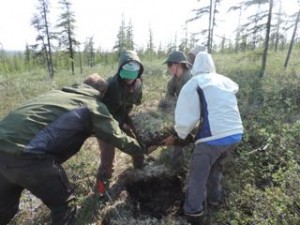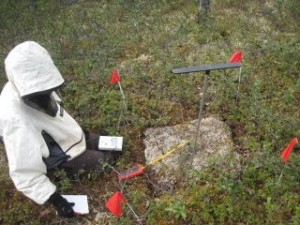I’ve always been drawn to the unassuming non-vascular plants. Maybe it’s the flashy colors that grab my eye, but I really dig the mosses and lichens. So, when we were deciding on projects, I landed on an idea that would let me literally dig up mosses and lichens. Here’s a short blurb about how the project panned out:
Mosses and lichens comprise the bulk of the ground cover in the boreal forest region of Northeastern Siberia. These two vegetation types often grow in distinct patches; mosses usually grow in association with shrubs and are found along a wide moisture gradient, while lichen patches are typically found in drier areas lacking shrubs. This characteristic distribution, in conjunction with physiological differences between mosses and lichens, may cause differences in microenvironment between the two functional groups. Specifically, the frozen soil may thaw more deeply under lichen patches in the warm season, because they have a shallower organic layer and may not insulate the soil as well as mosses.
We don’t know, however, if the vegetation type is driving changes in microenvironment or if the microenvironment is driving changes in vegetation cover. To determine the nature of this relationship, I excavated patches of lichen and moss and transplanted them with patches of the opposite functional type. For example, a 2 X 2 foot lichen “plug,” about the size of a bathroom rug, was removed from a lichen patch, while a moss plug of the same size was removed from a moss patch. These plugs were then transplanted with plugs of the opposite vegetation type.
After the transplant, I started measuring changes in microenvironment in these plots to determine how mosses and lichens modify their environment over time, if at all. To link these vegetation changes to whole-ecosystem carbon cycling, I am measuring CO2 fluxes in the transplant plots, in hopes of elucidating the relative impact of each vegetation type on the ecosystem carbon budget. Just as humans expel CO2 by breathing, plants and microbes emit CO2 into the atmosphere through respiration. A CO2 flux measurement will capture the magnitude of these emissions. It is important to assess contributions to CO2 fluxes from different vegetation types, because the composition of Arctic vegetation might change in a drier climate, with a potential shift away from mosses and towards lichens. If lichens increase thaw depth, producing a corresponding increase in CO2 flux, this shift in vegetative community may carry relevance for the entire Arctic ecosystem in a warming world.






Comment(1)-
Lindsey says
July 23, 2013 at 3:42 pmYay lichens! I look forward to hearing more about this project. Sounds like fun!